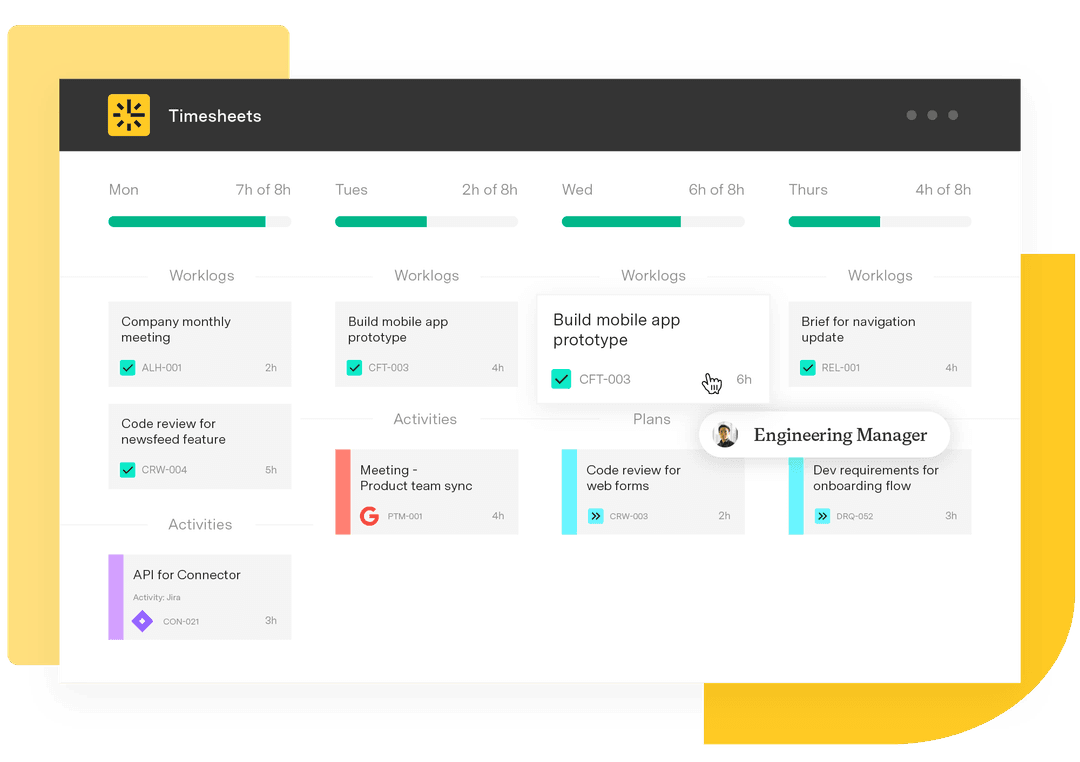Communication styles: Understand and adapt for better collaboration
Tempo Team
Effective communication isn’t just about what you say; it’s how you say it.
Even if a message seems perfectly clear to the speaker, it may land differently depending on the delivery and the audience, leading to miscommunications and interpersonal friction. Maybe a teammate shuts down during feedback, or a simple status update spirals into conflict. Chances are, it’s not about the message itself but the communication styles at play.
These styles shape the way we share ideas, respond under pressure, and interpret what others mean. And in dynamic project environments, mismatched communication styles can create tension – even when everyone’s working toward the same goal.
Fortunately, you don’t need to change your entire personality to communicate more effectively. With some self-awareness and the right tools, you can adapt your approach, connect better with your team, and build a smoother path to collaboration.
What are communication styles?
Some people talk in circles. Others get straight to the point. Some avoid confrontation at all costs, whereas others dive headfirst into tough conversations.
These aren’t just quirks – they’re clues about your team members’ communication styles.
So, what is a communication style? It’s the consistent approach a person takes when sharing ideas, processing information, and reacting during interactions. These patterns manifest in verbal communication styles (e.g., wording and tone) and nonverbal ones, like body language, facial expressions, and eye contact.
Here are different ways communication styles can influence interactions:
How one expresses disagreement or gives feedback
Whether one prioritizes clarity, emotion, or efficiency in conversation
How one presents themselves in meetings – confident, cautious, quiet, or commanding
How one handles conflict, stress, or unclear instructions
Whether one tends to speak up or stay silent when things go off track
Everyone leans toward a particular style of communication, and it’s often most pronounced when they’re under pressure. In a high-intensity workplace, it can make the difference between smooth collaboration and distracting tension.
Team members who can recognize different communication styles are better equipped to avoid misunderstandings and build stronger relationships. Understanding the types of communication styles your team members use – and becoming more aware of your own – helps you communicate assertively, collaborate with people who think differently, and make space for every voice on the team.
Whether you’re managing remote employees or trying to improve workplace communication, adjusting your communication style can significantly improve decision-making and conflict resolution.
The four types of communication styles
Everyone has a unique communication style influenced by their personality, experiences, and environment. Understanding these communication styles is essential in a team setting, where differences in communication can lead to misunderstandings or conflict.
Here are the four most common types of communication styles, their strengths, and potential challenges:
1. Passive communication
Passive communicators often hold back. They tend to prioritize others’ needs over their own, avoid confrontation, and stay quiet even when something matters deeply to them. You might hear a passive communicator say “I’m fine with whatever,” or “It’s no big deal,” even in highly consequential situations.
This communication style can stem from a desire to maintain peace or avoid being judged, but it often leads to unmet expectations, bottlenecks in workflow, or unspoken frustration.
Key strengths:
Reduces immediate conflict
Easy to get along with in group settings
Creates a calm environment
Common challenges:
Needs and opinions go unheard
Unaddressed issues can lead to resentment
Misses opportunities to contribute value
In the workplace:
Passive communicators may avoid giving feedback or voicing concerns during meetings. They might agree to deadlines or assignments they know aren’t realistic, leading to burnout or dropped balls later on.
2. Aggressive communication
Aggressive communicators often speak in ways that feel domineering or dismissive of others’ feelings. You’ll recognize this communication style when someone constantly interrupts, takes over conversations, or raises their voice to be heard.
Their confidence might come across as bold leadership, but it can discourage collaboration and leave team members feeling disrespected if left unchecked.
Key strengths:
Gets results quickly
Takes initiative
Pushes teams to act decisively
Common challenges:
Breaks trust or demoralizes others
Incites defensive responses
Shuts down open dialogue
In the workplace:
Aggressive communicators might overwhelm team meetings or deliver feedback without tact. Their tone can create fear or tension, even when they’re right. Being correct isn’t enough to convince teammates; one’s verbal communication style affects how the message is received.
3. Passive-aggressive communication
Passive-aggressive communicators express their frustration indirectly. Instead of being upfront, they might use sarcasm, subtle digs, procrastination, or the silent treatment to show displeasure. They may avoid confrontation, but their behavior still reflects underlying tension.
This style of communication can be confusing, especially in workplace communication, where clarity and honesty are key.
Key strengths:
Can maintain surface-level peace
Minimizes direct confrontation
Common challenges:
Erodes trust
Creates confusion or delays
Prevents honest conflict resolution
In the workplace:
You might notice a passive-aggressive communication style when a teammate “forgets” a task after disagreeing with a decision or responds to a request with sarcasm rather than a direct answer. These moments chip away at team cohesion and productivity.
4. Assertive communication
Assertive communication is the sweet spot – neither too blunt nor avoidant. Assertive communicators speak their minds clearly and respectfully. They express their needs, listen actively, and create space for others to do the same. This is the most effective and balanced communication style in fast-paced or cross-functional teams.
Alongside diplomatic wording, assertive communicators use body language, like open posture and steady eye contact, to foster effective communication.
Key strengths:
Encourages mutual respect and understanding
Supports honest feedback and healthy boundaries
Fosters collaboration, accountability, and trust
Common challenges:
May be misunderstood as “too direct”
Requires emotional awareness and confidence
In the workplace:
Assertive communicators give constructive feedback and handle tough conversations with empathy. Communicating assertively means advocating for one’s positions using facts and emotional intelligence, which helps align team goals and navigate tension. This style supports team synergy, conflict resolution, and managing up or across departments.
How to identify your communication style
Everyone has a default communication style, but we rarely stop to think about it or how it affects those around us. Reflecting on your communication skills can smooth out your interactions, strengthen team dynamics, and help improve your communication style in the workplace.
Here are a few ways to identify your style:
1. Examine how you express disagreement
Your response to disagreement provides a clear-cut indication of your communication style. Do you avoid confrontation and let things slide (passive communication), or do you confront issues head-on, even when it might make others uncomfortable (aggressive communication)?
Maybe you tend to express frustration indirectly, using sarcasm or subtle jabs (passive-aggressive communication), or you calmly and confidently state your opinion while respecting others’ perspectives (assertive communication). Examining these moments can highlight whether you avoid conflict or address it openly.
2. Remain conscious of your body language
Your body language often communicates more than your words. For example, closed-off body language, like crossed arms, avoiding eye contact, or slumped posture, can indicate discomfort or defensiveness, which is common in passive communicators. On the other hand, open gestures, firm handshakes, and steady eye contact are more characteristic of assertive communicators, who use body language to show confidence and engagement.
Aggressive communicators might use sharp gestures or invade personal space. In contrast, passive-aggressive communicators often exhibit subtle body cues, much like passive communicators, such as avoiding eye contact or using minimal gestures when speaking.
3. Reflect on your behavior under stress
Stress tends to magnify one’s default communication style. Observing your reactions during challenging moments offers some of the clearest insights.
Do you withdraw and avoid speaking up? Or do you become more blunt and confrontational? Some people turn sarcastic or start using the silent treatment when things get tense, indicating passive-aggressive tendencies. Others remain calm and solution-oriented, even under pressure – a hallmark of assertive communication.
4. Take a communication style assessment
If you’re unsure where you fall, try a communication style assessment. These tools ask questions about how you express yourself and handle conflict. The results can clarify whether you’re a functional communicator, analytical communicator, or lean toward other common styles – and why that matters. No quiz can define you completely, but they can point you in the right direction.
5. Note how others respond to you
Your style doesn’t just affect how you communicate. It also influences how others receive your message. Ask yourself:
Do people frequently misunderstand you?
Do team members avoid giving you feedback or seek you out for it?
Are there recurring conflicts with certain coworkers?
Feedback and reactions from others offer valuable clues about your communication style and how it’s perceived.
6. Consider your personality and preferences
Your natural tendencies significantly affect how you speak, listen, and react. For example:
Analytical thinkers may prefer direct, fact-based communication
Emotionally intuitive people may be more focused on tone and delivery
Some prioritize harmony and avoid confrontation, whereas others prefer clarity, even if it’s blunt
These differences don’t make one style better than another. They simply highlight the value of self-awareness and effective communication.
Support team communication with Tempo
Even when people share common goals, different communication styles can lead to missed signals or tension. That’s where Tempo steps in to ensure your team stays aligned, no matter their style.
Tempo’s Timesheets clarifies who’s working on what and when, reducing the need for constant updates or micromanaging. Custom Charts for Jira lets you tailor reports for different audiences – whether you’re speaking to analytical stakeholders who want the minute details or big-picture thinkers who prefer high-level summaries.
Tempo gives your team the visibility and context to collaborate effectively without relying on guesswork. Get started with Tempo today and make collaboration effortless.












































